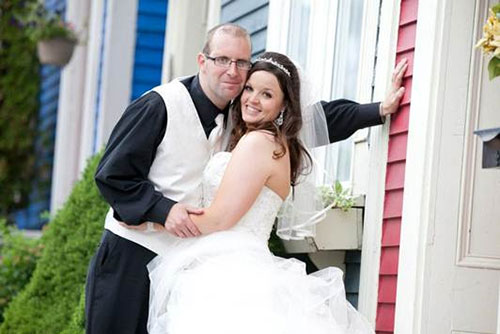
Jamie Wilkinson and Heather Lannon mapped out the discharge process from their perspective as patients. (Photo: Wilkinson and Lannon)
Perhaps it was coincidence, but perhaps it was fate that brought Jamie Wilkinson and Heather Lannon together.
First, Wilkinson, a junior high school teacher with a lilting Irish accent from Flatrock, NF, taught Lannon's sister. Then the two were co-workers at a children's camp. Fate successfully thrust them together for a third time at a bar in St. John's, five years after they first met.
Three years later, the couple was engaged.
Just two weeks before their wedding day Wilkinson's health sharply deteriorated. That's when the couple first found their way to the Peter Munk Cardiac Centre in 2012.
Luckily, they made it back to Newfoundland with 36 hours to spare before the wedding, but Wilkinson's congenital heart condition has brought him back to PMCC nine times since then.
Lending the patient perspective
 Their most recent visit has been their longest yet, and given their considerable experience with the discharge process, it's not surprising Zelia Souter, Nurse Manager at the PMCC, asked them to participate in the centre's first Lean rapid improvement event.
Their most recent visit has been their longest yet, and given their considerable experience with the discharge process, it's not surprising Zelia Souter, Nurse Manager at the PMCC, asked them to participate in the centre's first Lean rapid improvement event.
The event had several goals but most importantly for Wilkinson and Lannon, the team was tasked with developing a process to ensure every patient is discharged by 11:00 a.m.
Discharging patients on time creates additional capacity for the hospital – a huge relief during flu season when bed space is at a premium. For Wilkinson, it also meant less frustration and uncertainty during visits.
"When Zelia described the rapid improvement event and what they were trying to do I was kind of excited, Lannon said. "It sounded similar to my job at home." It turns out, Lannon worked for a provincial government agency, conducting investigations and making recommendations on process improvements.
That week, when Wilkinson was discharged from the PMCC, Lannon carefully noted their interactions with the care team and the times they occurred, without prompting staff to hasten the process.
"It was a fairly normal discharge," said Wilkinson. "We waited two to three hours at a time for things to happen. I was supposed to leave at 11:00 a.m., but I had to have bloodwork done first and that didn't start until after noon."
That night Lannon, in true Lean fashion, put Sharpie to Post-it, mapping out the discharge process as she and her husband had experienced it, then presented it to the team the next day.
"For the first two days we were struggling to look beyond the current discharge process," Souter explained. "We were stuck but Jamie and Heather's presentation was a breakthrough for us – it focused us and allowed us to see the gaps and the problems in our process."
Wilkinson is happy to have been helpful to the team.
"On Wednesday we went to the wards and asked patients what they thought about the new process," Wilkinson said.
"That's really great feedback to receive; it reminds staff what it's like to be a patient."
